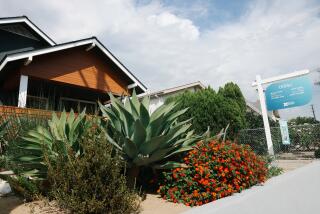California is building fewer homes. The state could get even more expensive

Ken Kahan makes a living building homes.
A specialty? Luxury apartment complexes in Los Angeles neighborhoods such as Palms and Silver Lake filled with mostly market rate units, but with a handful of income-restricted affordable ones as well.
It can be a good business, but lately less so.
“We have pulled back,” said Kahan, the president of California Landmark Group. “The metrics don’t work.”
Across California and the nation, developers moved to start fewer homes in 2023, a decline some experts say could eventually send home prices and rents even higher as supply shortages worsen.
Developers cite several reasons for delaying new projects. There’s high labor and material costs, as well as new local regulations that together make it harder to turn a profit.
Perhaps the biggest factor — and one hitting across the country — is the high cost of borrowing. Rising interest rates not only make it more expensive for Americans to buy a home, but they add additional costs for developers who must shell out more money to build and manage their projects.
As a result, fewer projects make financial sense to build and fewer homes are built.
“More than anything it is debt costs,” said Ryan Patap, an analyst for real estate research firm CoStar.
In all, preliminary data from the US. Census Bureau show building permits for new homes nationwide fell 12% in 2023 from the prior year and 7% in California. Drops were recorded in both single-family homes — most of which tend to be for sale — as well as multifamily homes — which are chiefly rentals.
Dan Dunmoyer, president of the California Building Industry Assn., said one major reason for the decline is that many for-sale home builders foresaw “a massive downturn” and stopped buying lots to develop when mortgage rates soared in 2022.
Then a funny thing happened. Demand for their product didn’t crater as much as expected, in large part because existing homeowners didn’t want to sell and rid themselves of ultra-low mortgage rates.
“Builders kind of woke up and realized ‘Oh, it’s just us [selling homes],‘” Dunmoyer said. “But we don’t turn on a dime.”
Explore the latest prices for homes and rentals in and around Los Angeles.
As for-sale builders restart their engines to take advantage of a shortage of listings, there are signs of improvement. During the first two months of this year, builders in California pulled 35% more permits for single-family homes than during the same period a year earlier, according to census data.
Permits for multifamily continued to decline — dropping 33%.
The diverging paths are probably due to several factors, said Rick Palacios Jr., director of research for John Burns Research and Consulting.
On a whole, single-family home builders have access to a wider source of debt that isn’t as vulnerable to rising interest rates. In the single-family market, the supply shortage has also worsened and home prices are climbing.
Meanwhile, rents in many places — including Los Angeles — have dropped slightly as vacancies have risen, in part because apartment construction has been relatively robust in recent years.
“Single-family solid, multifamily weak is a pretty consistent theme across most of the country,” Palacios said. “You’re hard pressed to find a market where developers and investors are gung ho on apartments.”
In the city of Los Angeles, developers must contend with another factor — Measure ULA.
The citywide property transfer tax took effect last year to fund affordable housing and has drawn the ire of the real estate industry.
Though it’s known as the “mansion tax,” except for rare exceptions it applies to all properties sold for more than $5 million, no matter if they are gas stations, strip malls, apartment buildings or actual mansions. Under the measure, a seller is charged 4% of the sales price for properties sold above $5 million and below $10 million.
At $10 million and above, the tax is 5.5%.
Apartment developers and real estate brokers said additional costs from ULA make it even harder to earn a reasonable profit in what can be a risky business.
That’s because when building apartments, developers often sell their finished product, which would probably trigger the ULA tax for any building over 15 units, according to Greg Harris, a real estate broker with Marcus and Millichap. Even developers who hold onto their properties typically need to take out a mortgage on the finished building — and Harris said lenders are willing to give less because they too would need to pay the tax if they foreclose and sell the property.
“ULA is like the last nail in the coffin,” said Robert Green, a Los Angeles developer. “It couldn’t have come at a worse time.”
Many apartment projects got their start under different economic circumstances and have opened in recent years or will soon. That supply should help keep rents down for a while, but not forever, said Richard Green, executive director of the USC Lusk Center for Real Estate.
In two or three years, as fewer apartments are finished “we will see rent start to go up again,” he said.
That would be a hit for Californians struggling to find housing in an expensive state where thousands sleep on the streets.
Economic cycles, of course, ebb and flow and construction may rebound.
The Federal Reserve plans to cut interest rates later this year, which may help more projects make sense financially, as could rising rents.
Land sellers could also drop their asking prices to adjust for rising developer costs, including ULA in Los Angeles.
Normally, real estate analyst Patap said he’d expect apartment construction to rebound as land costs adjust downward. But he noted developers say they are also cautious about building in L.A. because of a broader political shift in the city that’s more supportive of restrictions on landlords and more supportive of protections for tenants.
In the city of Los Angeles, multifamily permits dropped 24% in 2023 compared with 19% in Los Angeles County, census data show. (Data from the Construction Industry Research Board show even larger drops: 49% in the city and 39% in the county.)
Laurie Lustig-Bower, a commercial real estate broker with CBRE, said some L.A. landowners have reduced their prices to sell, but “if they don’t have a gun to their head” they are waiting until developers can pay more.
In recent years, state lawmakers have taken action to make it easier to build housing, in part by eroding local control over land use decisions.
Los Angeles Mayor Karen Bass has also fast-tracked 100% affordable buildings under her Executive Directive 1, while the city recently exempted smaller projects from some storm water capture requirements.
Mott Smith, chairman of the Council of Infill Builders, said more must be done to increase the number of new homes in Los Angeles and cited the storm water decision as the kind of steps government should take.
“The city has no influence over interest rates ... [but] what it controls is the process to get a project approved,” Smith said. “There are so many opportunities.”
For now, developers say it’s tough to find opportunities.
Kahan said his company runs the numbers on potential land purchases constantly and at least once a week finds it doesn’t make sense to buy and build.
He expects to purchase some land in Southern California by year’s end, though mostly outside of the city of Los Angeles where Kahan said he’s increasingly looking because of costs from ULA, which unlike current interest rates aren’t expected to change.
So far, Kahan said he’s yet to find a deal that will work — within or outside city borders.
More to Read
Start your day right
Sign up for Essential California for news, features and recommendations from the L.A. Times and beyond in your inbox six days a week.
You may occasionally receive promotional content from the Los Angeles Times.








